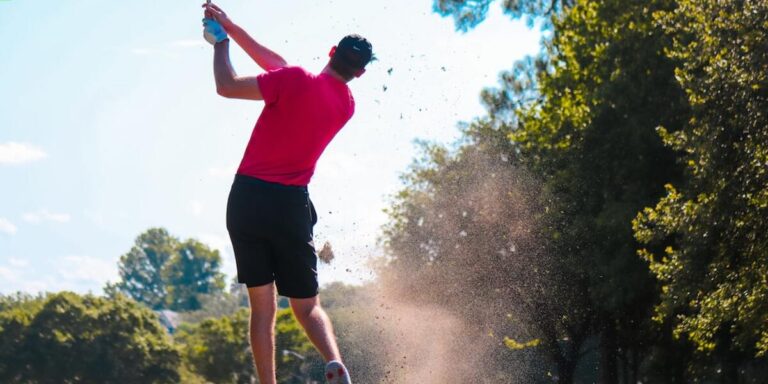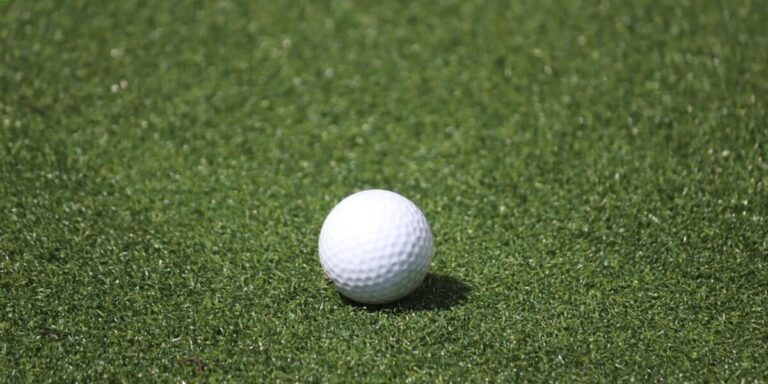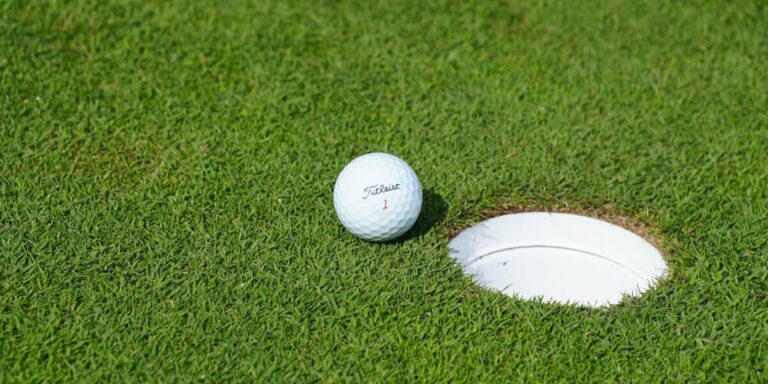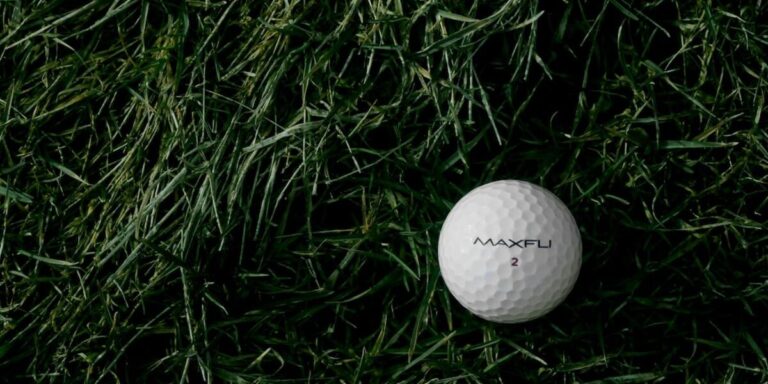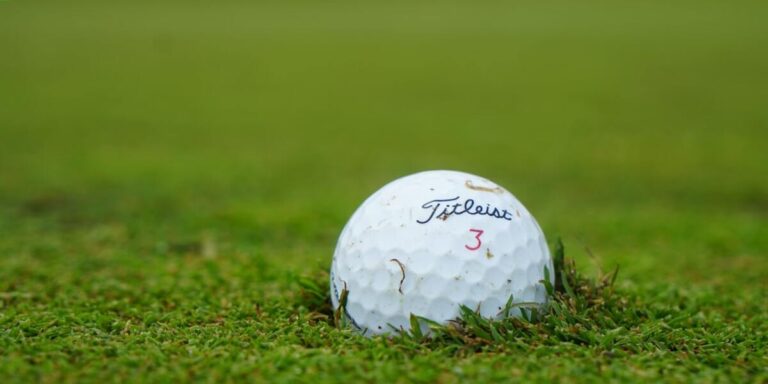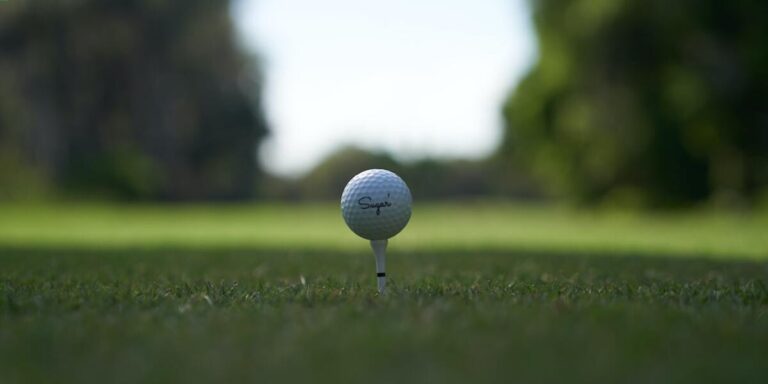Can you change a damaged golf ball during a hole?
In golf, a player is allowed to bring up to 14 clubs and 3 golf balls with them on the course. If a ball becomes damaged during play, it can be changed out for another one from the player’s bag. However, there are some specific rules that must be followed when changing a golf ball.
For starters, if a golfer wants to change their ball, they must do so between holes – meaning they cannot stop mid-hole to make the switch. In addition, the replacement golf ball must not be of a better quality than the one that was lost or damaged. So if a player only has Titleist Pro V1s in their bag and they lose their ball on hole number 5, they cannot replace it with a brand new Pro V1 that they just bought at the pro shop before teeing off on hole 6.
There are also situations where players are not allowed to change their golf balls at all. One example would be if two different players hit each other’s balls by accident and there is no way to tell whose ball is which – in this case, both players would have to finish the rest of the round with whicheverball ended up closer to the hole (no matter what kind it was). Another instance where you wouldn’t be ableto change your damaged or lost golf ball would beif it goes into water – whether it’sa hazard or not – as soon as agolfers BALL entersthe wateritis considered LOSTandthey CANNOT retrieveit OR exchangeit foranotherone without takinga penalty stroke(which we’lldiscussin more detaillater).
Can You Change a Damaged Golf Ball While Playing a Hole?
Golf is a frustrating game. You can be doing everything right and still end up with a bad shot. And sometimes, those bad shots can damage your golf ball. If you’re playing a hole and your ball gets damaged, you may be wondering if you can change it out for a new one.
The answer is yes, but there are some stipulations. According to the Rules of Golf, if your ball becomes ” unfit for play ” during the course of a hole, you are allowed to replace it with a new one . There are two main conditions that would make a golf ball unfit for play: physical damage and waterlogging .
If your golf ball sustains physical damage, such as cracks or dents , it is no longer fit for play and you can replace it. Waterlogging happens when a golf ball absorbs too much water , making it heavier and affecting how far it will travel when hit . If your golf ball starts absorbing water from the wet fairway or green ,it’s time to get rid of it and grab a fresh one from your bag.
How to Fix a Damaged Golf Ball
Golf balls are designed to withstand a lot of wear and tear, but they’re not indestructible. If you’ve damaged your golf ball in some way, there are a few things you can do to try and repair it.
First, if the damage is just cosmetic, such as scuffs or scratches, you can try buffing it out with a soft cloth. You might be able to remove minor blemishes this way.
If the damage is more than skin deep, such as dents or cracks, then you’ll need to take more drastic measures. One option is to fill the dent or crack with superglue or another type of strong adhesive. Once it’s dry, sand down the area until it’s flush with the rest of the ball.
Another option is to simply replace the damaged golf ball with a new one. This is probably the best solution if the damage is severe enough that it affects how the ball flies through the air. No matter what method you choose, make sure to test out your repaired golf ball before using it in an actual game!
When is it Appropriate to Change a Golf Ball?
Most golfers don’t think twice about changing their golf balls when they start to show signs of wear. But is this really the best time to make the switch? Here’s a look at when it might be appropriate to change your golf balls.
1. When They’re Worn Out: Obviously, the biggest reason to change your golf ball is when it’s starting to show signs of wear and tear. If the cover is beginning to peel off or cracks are forming, it’s time for a new ball. Not only will a worn-out ball adversely affect your game, but it can also pose a safety hazard if it breaks apart during play.
2. When They Lose Their Bounce: Another key indicator that it’s time for new golf balls is when they lose their bounce. If you notice that your shots aren’t traveling as far as they used to, or the ball isn’t reacting the same way off of different club faces, then freshballs may be in order. This could be due to compression loss, which affects how much energy is imparted on each shot..
3 vital things occur during Machone Golf’s compression process: our unique spherical dimple patterns are cut intooccur during Machone Golf’s compression process: our unique spherical dimple patterns are cut into shape by CNC machines; an advanced polymer core material undergoes heat and pressure treatments until its molecules align perfectly; finally, an aerodynamic mantle layer wraps everything together tightly so nothing shifts during flight – resulting in longer drives with amazing accuracy
Different Ways to Change Your Golf Ball
Different Ways to Change Your Golf Ball:
1. If you’re looking for a new golf ball, there are a few things you can do to change things up. You can try a different brand, or a different type of ball. Or, you can switch to a harder or softer ball. Here are some things to keep in mind when changing your golf ball.
2. When it comes to choosing a new golf ball, the options can seem endless. But don’t worry, we’re here to help! First, think about what kind of player you are. Are you someone who wants maximum distance? Or do you prefer more control around the greens? Once you know what’s important to you, narrowing down your choices will be much easier.
3 . Another thing to consider when changing golf balls is the cover material . The cover is the outer layer of the ball that gives it its spin and feel characteristics . So if you’re looking for more spin , chances are y ou’ll want A two-piece construction with an ionomer cover .”
Tips for Changing Your Golf Balls During Play
1.Changing your golf balls during play can be a great way to improve your game. Here are a few tips to keep in mind when you’re changing golf balls:
2. First, choose the right type of ball for your game. There are many different types of golf balls on the market, so it’s important to find one that suits your playing style. If you’re not sure which type of ball is best for you, ask a professional or consult with a knowledgeable friend before making your purchase.
3 . Once you’ve chosen the right ball, pay attention to how it feels during play. If you notice any changes in its performance, such as loss of distance or decreased spin rate, it’s time to change out your golf ball. Also, be sure to inspect the condition of the ball after each shot; if it shows signs of wear and tear (e..g., cracks or scuffs), it needs to be replaced immediately!
4 . Finally, don’t forget about proper storage when you’re not using your golf balls. Be sure to keep them clean and dry in an airtight container – this will help extend their lifespan and ensure they perform at their best next time you hit the links!
Reasons Why You Should Never Play with Damaged golf balls
There are many reasons why you should never play with damaged golf balls. For one, they can cause your ball to veer off course and into trouble. Additionally, damaged balls can also impact your score if they don’t travel as far as they should. Finally, playing with damaged golf balls is simply bad etiquette and will likely annoy other players on the course.
So what counts as a “damaged” golf ball? Anyball that has cracks or abrasions on its surface is no longer fit for use. Once a ball gets nicked or scuffed, it’s aerodynamic properties are compromised and it won’t fly as straight or as far as a new ball would. So not only will playing with a damaged golf ball put you at a disadvantage, but it could also result in lost balls (and money!)
If you find yourself frequently losing golf balls or just want to improve your game, consider investing in some high-quality Mach ONE Golf Balls . They’re designed for maximum distance and accuracy so you can play your best round yet!
The Consequences of Not Changing Your golf ball
The average golfer uses about a dozen golf balls per round. That means, over the course of a year, you could go through as many as 300 golf balls. Now, think about how often you change the oil in your car. Most people do it every 5,000 miles or so. So if you driving 15,000 miles per year, that would be three oil changes.
Now imagine if you never changed your oil – ever. What would happen? The same thing that happens when you don’t change your golf balls: long-term damage and decreased performance. Here are some specific consequences of not changing your golf ball on a regular basis:
1) Damage to club faces: If you hit a rock with your club face while using an old ball, there’s a good chance the cover will suffer some type of puncture or cut. This can lead to permanent damage to your clubs and decreased distance off the tee. Not to mention, those divots aren’t going to heal themselves!
2) Decreased Distance and Accuracy: A new golf ball has dimples which help create lift and spin for longer drives and straighter shots Even if there are no visible signs of wear on an old ball, its dimples have likely become flattened from use . This reduces both distance and accuracy..3) Higher Scores : If you’re not playing with fresh equipment , chances are good your scores will begin to suffer as well In addition , used golf balls simply don’t provide the same “feel ” off the clubface that newer ones do After all , part of the game is enjoying yourself; why make it harder (and more frustrating ) by using inferior equipment? Regularly changing out your
Frequently Asked Question
-
Can you change a damaged golf ball during a hole?
-
Do pro golfers change balls every hole?
-
Are you allowed to play 2 balls on a golf course?
-
What is a two ball in golf?
-
How do machine golf balls work?
-
What golf ball is better?
-
What happens if a golfer runs out of balls?
-
What is a gutta percha golf ball?
-
Are there any collectable golf balls?
-
Can you switch golf balls to putt?
-
Why do they call it Four-Ball?
-
What is Rule 4.2 in golf?
-
What is best ball in golf?
-
When should you throw away a golf ball?
Rule 4.2c was in play. It stated: If your ball has been damaged during play, you may not substitute it with another one. However, if the ball’s paint or scratch is minor or is just slightly scratched or scraped off it will still be allowed to replace it.
Alex Chiarella won the tournament without having to change any golf balls for 72 holes. This is a rare occurrence in modern pro-golf. New balls can be a valuable resource for pro golfers, even those on mini-tours. They are not patient for any flaws in the equipment or their swings.
One player may play no more than 2 balls, provided he does not hold back play from others. Murph and I often play more. However, this is generally green side or putting.
What is Two-Ball betting? The two-ball wager is a type of head-to-head betting. You don’t have to pick one player to win a field of 156 golfers over 4 rounds. Instead, bet on one person to shoot lower than their opponent over 18 holes.
The RFID tag is connected to the next golf ball when you pass your golf club across the sensor. It knows it is your ball by that.
Better-Ball is a best-ball competition where the two teams consist of one player. Match play is better-ball, which can also be called Four Ball Better Ball. Each player plays their ball during the round.
You can always borrow a ball from another player if you run out. In stroke play, a misplayed ball can result in a loss of a hole or a penalty of two strokes.
Golf balls were originally made of leather bags stuffed with boiled eggs. The gutta percha, which was a brand new type of golf ball, replaced the old “feathery” in 1848. Gutta-percha was made from hardened juice from South American and Pacific Islands trees.
Gourlay and McEwan are among the most sought-after names. These balls can fetch huge sums of money at auction, especially if they are in excellent condition. To collect such balls, you need to have the knowledge and experience necessary for determining their worth and authenticity.
Your golf ball cannot be switched out on the putting course. After a player has started to tee off, they cannot switch their golf balls. Your ball can be marked and replaced on the green. However, you are not allowed to switch with another golf club.
Four-Ball got its name from where? Name Four-Ball was first published in 1908 R&A’s Rule Book. It came from the fact there were always four balls at once in a match. Four-Ball Stroke Play was not included in the Rules before 1952.
Rule 4.2c was in play. It stated: If your ball has been damaged during play, you may not substitute it with another one. However, if the ball’s paint or scratch is minor or is just slightly scratched or scraped off it will still be allowed to replace it.
In the Ryder Cup, best ball is played in 2-person teams. Each player plays their own ball during the round. The team score is determined by the score of each player in the two-person team whose hole score (or the best ball) was the lowest.
A golf ball that is not damaged can be used for up to seven rounds of 18 holes without losing its performance. You are actually more likely to drop a ball of golf on the green than it is just wearing out. However, it is best to replace the golf ball as soon as you feel that it feels rough.
Conclusion
The answer is a resounding yes! You can change a damaged golf ball during a hole, but it may not be the best idea. If you’re playing with friends, they might not appreciate having to wait for you to make your shot. And if you’re playing alone, well, it’s just more fun to play with a new ball. So do your research before purchasing online and look for trusted links and reviews on our website.


